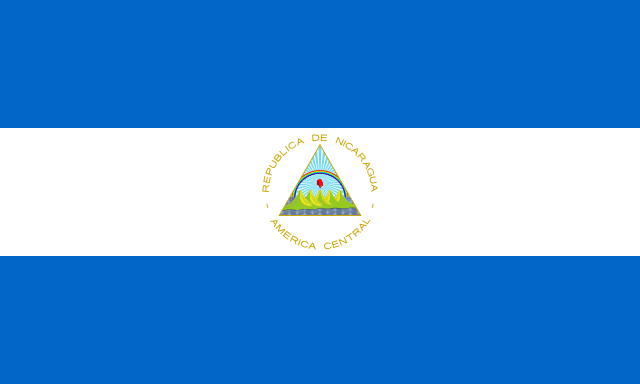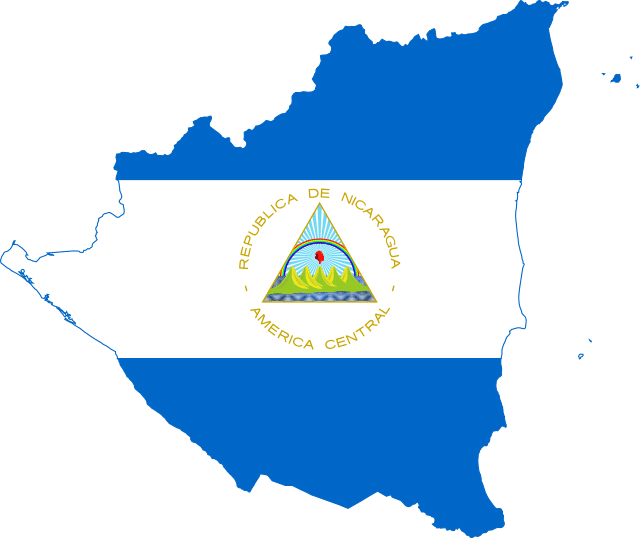With its breathtaking scenery and varied population, Nicaragua is a shining example of the region’s natural splendor and cultural diversity. Nicaragua’s natural attractions, which range from imposing volcanoes to abounding rainforests, immediately capture the mind. The same can be said about the Nicaragua flag.
The country’s flag represents its history, personality, and perseverance. The flag’s vibrant colors and symbols embody the spirit and determination of the Nicaraguan people.
In this article, we examine the flag’s design, symbolism, and intriguing history while also delving further into its deep meaning.

Overview of Nicaragua: Country Profile
Nicaragua, a place of stunning geographic variety and rich demographics, is a nation represented by a bright flag that symbolizes its national pride. Nicaragua is located in Central America. The country’s scenery includes majestic volcanoes, luscious jungles, immaculate beaches, and serene lakes.
Nicaragua’s western coast is bordered by the Pacific Ocean, while its eastern shoreline is encircled by the Caribbean Sea. Honduras and Costa Rica are neighbors to the north and south, respectively. The nation is well known for its stunning geography, which includes a series of volcanoes that dominate the landscape.
Several prominent volcanoes, like the towering Momotombo, beautiful Concepción, and enigmatic Maderas, decorate the Nicaraguan terrain, providing a dramatic backdrop to the country’s natural splendor.
Nicaragua is home to extensive tropical rainforests overflowing with diverse flora and wildlife, in addition to its volcanic beauties. One of the biggest jungles in the Americas, the Bosawás Biosphere Reserve, and the Indio Maíz Biological Reserve are examples of the nation’s dedication to environmental preservation. Additionally, Nicaragua is endowed with beautiful waterways like Lake Nicaragua, the biggest lake in Central America, and the tranquil Pearl Cays, which provide a tranquil getaway for water and nature lovers.
Nicaragua uses Central Standard Time (CST) as its primary time zone all year round. The absence of DST in the nation ensures accurate time in Nicaragua and few interruptions to everyday activities. A consistent time zone makes it possible for both inhabitants and visitors to organize and coordinate their activities effectively.
The people of Nicaragua represent a diverse range of racial and cultural groups. Mestizos, who combine Native American and European descent, make up the bulk of the population. The country’s cultural diversity is influenced by indigenous groups such as the Miskito, Mayangna, and Garifuna. Small communities of people of African ancestry and European ancestry also exist in Nicaragua, adding to the country’s diverse demographic makeup.
Nicaragua’s capital and largest city, Managua, is a thriving metropolis with a multicultural populace. Other significant cities like León, Masaya, and Granada add to the urban environment of the nation by presenting distinctive historical and cultural landmarks.

Design & Symbolism of Nicaragua Flag
The Nicaragua flag boldly waves in the breeze and is made up of three horizontal blue and white stripes that stand for the nation’s ideals. Let’s examine the size, symbols, and design components that make the flag a symbol of national pride and unification.
Color Scheme
The Nicaragua flag has three stripes that are all the same width and are horizontal. The center stripe is white, while the top and bottom stripes are sky blue. When these hues are blended, they create an eye-catching contrast that draws attention and inspires feelings of harmony and peace.
What Does the Flag Represent?
The Nicaragua flag’s blue stripes stand for the Pacific and Caribbean oceans, which border the country to the west and east, respectively. The country’s physical position as a bridge between the two bodies of water is reflected in this symbolism. Furthermore, it symbolizes the significant impact that the seas have had on Nicaragua’s history, culture, and economy.
The white stripe, which is in the center, has significant importance. It stands for innocence, tranquility, and Nicaraguans’ desire for justice and equality. It serves as a potent reminder of the country’s dedication to upholding peace and building harmony both at home and abroad.
Dimensions & Shapes
The Nicaragua flag maintains a conventional rectangular shape. It has a length-to-breadth ratio of 2:2, or a 3:5 ratio. The breadth of the flag evenly distributes the height of the blue and white stripes, producing a pleasing equilibrium. The flag’s size ensures that it keeps its distinctive appearance whether it is flown from towering flagpoles or exhibited more intimately.
History of Nicaragua Flag
The Nicaragua flag has traveled a fascinating road through history, representing the country’s tribulations, victories, and aspirations. The flag has experienced major changes from its birth to the present, reflecting the nation’s dynamic past.
Early Years and Creation
The Nicaragua flag’s creation may be dated to the region’s struggle for independence from Spanish authority in the early 19th century. The United Provinces of Central America, which included Nicaragua, became independent in 1821. The modern flag, on the other hand, wasn’t established until 1823. Juan Pablo Duarte, a politician and military commander from Nicaragua, is credited with creating the flag’s design.
Initial Concept of the Flag
The national coat of arms was shown in the middle of the country’s initial flag, which had blue and white horizontal stripes. The physical position of the nation was symbolized by the coat of arms, which showed an isthmus encircled by water. The solidarity of Nicaragua with the other countries of Central America and its hopes for peace and prosperity were symbolized by this artwork.

Evolution and Important Milestones
To represent the shifting socio-political climate, the Nicaragua flag experienced modest changes over time. Several significant junctures in its history include:
The Central American Federation broke up in 1838, which paved the way for the creation of distinct nation-states. The coat of arms was removed from Nicaragua’s flag, but the blue and white stripes were kept.
During the American filibuster William Walker’s conquest of Nicaragua in 1854–1855, the flag underwent a brief evolution. Walker used a blue field with a single white star in the canton to represent his desire to build an empire in Central America.
In 1908, the flag’s original blue and white striped pattern was reinstated. Minor alterations were made to the coat of arms, which now includes the nation’s recognizable volcanoes and a rainbow as a representation of peace and prosperity.
In 1971, blue and white horizontal stripes without the coat of arms were added to the modern Nicaragua flag, which was then formally approved. The emphasis on the nation’s unity and the eternal principles that the flag stands for was one of the goals of this streamlined design.

History of Nicaragua’s Coat of Arms
The United Provinces of Central America, which included Nicaragua at the time, is where the country’s coat of arms’ first known iterations can be found. The newly independent Central American governments, including Nicaragua, adopted a national coat of arms in 1823 that reflected their shared identity and ambitions.
The Nicaragua coat of arms is defined by its circular form, which contains a complex weave of many symbolic components. Five volcanoes, a rainbow, a Phrygian cap, and a laurel wreath make up the pattern.
The five volcanoes on Nicaragua’s coat of arms, Momotombo, Concepción, Maderas, Masaya, and Ometepe, stand for the country’s most significant volcanoes. These volcanoes are of tremendous geographic and cultural significance, displaying the beauty of Nicaragua’s natural surroundings and the fortitude of its inhabitants.
The rainbow represents Nicaragua’s hopes for a peaceful and unified country and is a sign of wealth. It represents the nation’s variety and rich cultural heritage while highlighting the value of maintaining unity in the face of diversity.
The Phrygian cap is located at the top of the coat of arms. It is often referred to as a “liberty cap.” This archaic emblem stands for liberty and the struggle for independence. It honors the sacrifices made by the Nicaraguan people in their fight for independence.
The main design is surrounded by a laurel wreath and represents success, honor, and triumph. It serves as a reminder of the tenacity and fortitude of the Nicaraguan people and signifies the nation’s accomplishments, both past and present.
Nicaragua Flag Protocol
- The flag should be raised on a flagpole swiftly and respectfully, making sure it reaches the top without tangles. Slowly and ceremoniously, it should be lowered.
- The flag is flown at half-staff as a show of respect or grief. The flag should be hoisted to its highest point before being lowered to the midway point. This should be done carefully and precisely.
- The Nicaragua flag should always have pride of place when displayed alongside the flags of other countries. It’s often flown with the left side toward the front.
Bottom Line
The Nicaragua flag conveys the difficulties, accomplishments, and aspirations of the nation. The red, white, and blue ribbons stand for the sacrifices made by heroes, the innocence of the populace, and the sky that envelops their hopes. The flag is a potent symbol that captures the essence of a country, giving its people a sense of identity and serving as an inspiration for the people of the country.